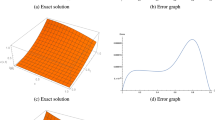Abstract
A fast multipole method (FMM) based on complex Taylor series expansions is applied to the dual boundary element method (DBEM) for large-scale crack analysis in linear elastic fracture mechanics. Combining multipole expansions with local expansions, both the computational complexity and memory requirement are reduced to O(N), where N is the number of DOF. An incremental crack-extension analysis based on the maximum principal stress criterion and the Paris law is used to simulate the fatigue growth of numerous cracks in a 2D solid. Some examples are presented to validate the numerical scheme.
Similar content being viewed by others
References
Cruse TA (1996) BIE fracture mechanics analysis 25 years of developments. Comput Mech 18(1):1–11
Cruse TA (1988) Boundary Element Analysis in Computational Fracture Mechanics. Kluwer, Dordrecht
Lachat JC, Watson JO (1976) Effective numerical treatment of boundary integral equations: a formulation for three-dimensional elastoplastic. Int J Numer Meth Eng 10:991–1005
Blandford GE, Ingraffea AR, Liggett JA (1981), Two-dimensional stress intensity factor computations using the boundary element method. Int J Numer Meth Eng 17:387–404
Portela A, Aliabadi MH (1992) The dual boundary element method: effective implementation for crack problems. Int J Numer Meth Eng 33:1269–1287
Portela A, Aliabadi MH, Rooke DP (1993), Dual boundary element incremental analysis of crack propagation. Comput Struct 46(2):237–247
Mi Y, Aliabadi MH (1992) Dual boundary element method for three-dimensional fracture mechanics analysis. Eng Anal Bound Elem 1:161–171
Cisilino AP, Aliabadi MH (1997) Three-dimensional BEM analysis for fatigue crack growth in welded components. Int J Pressure Vessels and Piping 70:135–144
Wilde AJ, Aliabadi MH (1999) A 3-D Dual BEM formulation for the analysis of crack growth. Comput Mech 23:250–257
Leitão VM, Aliabadi MH, Rooke DP (1995) The dual boundary element formulation for elastoplastic fracture mechanics. Int J Numer Meth Eng 38:315–333
Cisilino AP, Aliabadi MH (1998) A three-dimensional dual boundary element formulation for the elastoplastic analysis of cracked bodies. Int J Numer Meth Eng 42:237–256
Cisilino AP, Aliabadi MH (1999) Three-dimensional boundary element analysis of fatigue crack growth in linear and non-linear fracture problems. Eng Frac Mech 63:713–733
Peirce AP, Napier JAL (1995) A spectral multipole method for efficient solutions of large scale boundary element models in elastostatics. Int J Numer Meth Eng 38:4009–4034
Fu YH, Klimkowski KJ, Rodin GJ (1998) A fast solution method for three-dimensional many-particle problems of linear elasticity. Int J Numer Meth Eng 42:1215–1229
Popov V, Power H (2001) An O(N) Taylor series multipole boundary element method for three-dimensional elasticity problems. Eng Anal Bound Elem 25:7–18
Yoshida K, Nishimura N, Kobayashi S (2001) Application of new fast multipole boundary integral equation method to crack problems in 3D. Eng Anal Bound Elem 25:239–247
Yoshida K, Nishimura N, Kobayashi S (2001) Application of fast multipole Galerkin boundary integral equation method to elastostatic crack problems in 3D. Int J Numer Meth Eng 50(3):525–547
Wang HT, Yao ZH (2005) A new fast multipole boundary element method for large scale analysis of mechanical properties in 3D Particle-reinforced composites. Comput Model Eng Sci 7(1):85–95
Wang HT, Yao ZH (2004) Application of a new fast multipole BEM for simulation of 2D elastic solid with large number of inclusions. Acta Mech Sin 20(6):613–622
Nishimura N (2002) Fast multipole accelerated boundary integral equation methods. Appl Mech Rev 55(4):299–324
Barnes J, Hut PA (1986) Hierarchical O(NlogN) force calculation algorithm. Nature 324:446–449
Greengard L, Rokhlin V (1997) A fast algorithm for particle simulation. J Comput Phys 135:280–292
Wang PB, Yao ZH, Wang HT (2005) Fast multipole BEM for simulation of 2-D solids containing large numbers of cracks. Tsing Scien Technol 10(1):76–81
Guiggiani M (1992) A general algorithm for the numerical solution of hypersingular boudary integral equations. J Appl Mech 59:604–614
Vavasis SA (1992) Preconditioning for boundary integral equations. SIAM J Matrix Anal Appl 13(3):905–925
Mukhopadhyay NK, Maiti SK, Kakodkar A (2000) A review of SIF evaluation and modelling of singularities in BEM. Comput Mech 25:358–375
Aliabadi MH, Rooke DP (1992) Numerical Fracture Mechanics. Computational Mechanics Publications, Dordrecht
Tanaka K (1974) Fatigue crack propagation from a crack inclined to the cyclic tensile axis. Eng Frac Mech 6:493–507
Isida M (1971) Effects of width and length on stress intensity factor for the tension of internal cracked plates under various boundary conditions. Int J Fract Mech 7:301–306
Author information
Authors and Affiliations
Corresponding author
Rights and permissions
About this article
Cite this article
Wang, P., Yao, Z. Fast multipole DBEM analysis of fatigue crack growth. Comput Mech 38, 223–233 (2006). https://doi.org/10.1007/s00466-005-0743-9
Received:
Accepted:
Published:
Issue Date:
DOI: https://doi.org/10.1007/s00466-005-0743-9




